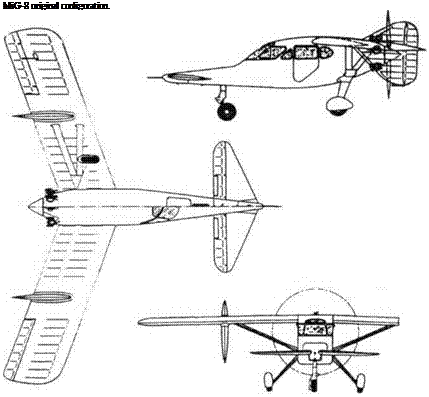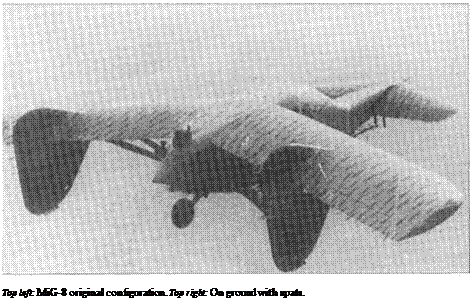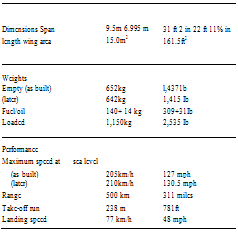MiG-8 Utka

Purpose: To create a safe and easily flown light aeroplane.
Design Bureau: OKB-15 5 ofAI Mikoyan.
Previously famous for a succession of high – performance fighters, the MiG bureau began to relax as the Great Patriotic War ended. Without any requirement from GUAP, Aeroflot or anywhere else, its principals decided to investigate the design of a light air
craft with an M-ll engine which could replace the Po-2 (originally designated U-2) as a machine which could be safely flown by any pilot from almost any field. The project was assigned to students at the WA (air force academy) under Col (later Professor) G A Tokayev. The OKB kept a close watch on the design, and soon judged that its slightly swept wing could be useful in assisting the design of future jet fighters. The main elements ofthe design were settled by July 1945, and thereafter construction was rapid. The aircraft was named Utka (duck) because of its canard configuration. Aleksandr Ivanovich Zhukov made the first flight on 19th November 1945. The wingtip fins and rudders proved unsatisfactory, and for the next six months the MiG-8 was modified repeatedly, as explained below. Its flight testing was handled by OKB pilot Aleksei Nikolayevich Grinchik, assisted by I Ivashchenko and other pilots of the LII MAP (Ministry Flight Research Institute). By the summer of 1946 the MiG-8 was considered more or less perfect. No explanation is available for the fact that this aircraft never went into production as the Po-2 replacement. The MiG-8 was used for many years as the OKB’s communications aircraft, and also as a test-bed for various kinds of research.
The MiG-8 was a small cabin aircraft distinguished by a pusher engine at the tail, a canard foreplane and a high-mounted wing at the rear. Construction was of wood, mainly pine, with ply skin over the fuselage, wing leading edge and fixed foreplane. The wing had Clark Y-H section, with a thickness/chord ratio of 12 per cent. In plan the wings were untapered but swept back at 20°, with V-struts to
|




the bottom ofthe fuselage. The fuselage comprised a cabin with a door on each side, tapering at the rear around the M-11F radial engine rated at HOhp, driving a 2.36m (7ft 9in) two-blade wooden propeller. A total of 195 litres (43 Imperial gallons) of fuel was housed in aluminium tanks in each wing. At the front of the cabin a Po-2 instrument panel was installed for the pilot, and two passenger seats were added behind, with a small space for luggage behind them. Ahead of the cabin a slender nose was added to carry the delta foreplane, fixed at 3° incidence. This was fitted with fabric-covered elevators provided with trim tabs, with movement of ±25°. Total foreplane area was 2.7m2 (29ft2). On the outer wings were fabric-covered ailerons, ahead of which were large fixed slats on the leading edge. On the wing tips were delta-shaped fins carrying one-piece rudders, with a total combined area of 3m2 (32.3ft2). All control surfaces were operated by rods and bellcranks. The landing gear comprised a levered-sus – pension nose unit with a 300x150mm tyre, and spatted mainwheels with 500 x 150mm tyres and pneumatic brakes on cantilever legs pivoted to the strut attachment bulkhead, with bungee shock absorbers in the fuselage. Provision was made for skis, but no photographs show these fitted. The first flight showed that directional stability was poor. The wing was given 1 ° anhedral, and the fins and rudders were moved in to 55 per cent of the semi-span and mounted vertically, with a mass balance projecting ahead from the bottom of each rudder. The spats were removed, and a new nose gear was fitted with the same wheel/tyre as the main units. Later the wing anhedral was increased to 2°. Considerable attention was paid to engine cooling, and eventually the projecting cylinders were fitted with individual helmets, though no photographs have been found showing this (they were eventually removed except over the two bottom cylinders). In its final form the MiG-8 had a single fuel tank between the firewall and engine. An important further modification was to remove the slats, and photographs also show that in the final configuration the wingtips were angled downwards. At one time the entire aircraft was covered with tufts to indicate the airflow. In its final form the MiG-8 was nice to fly, and recovery from a spin was achieved merely by releasing the flight controls.
Despite its unusual configurationthe MiG-8 was eventually developed into an excellent aircraft, safe to fly and easily maintained, though at the end of the day it was j udged that future jet fighters should not have a canard configuration. No explanation has been given for the fact that the MiG-8 never led to production utility, ambulance or photographic aircraft.










